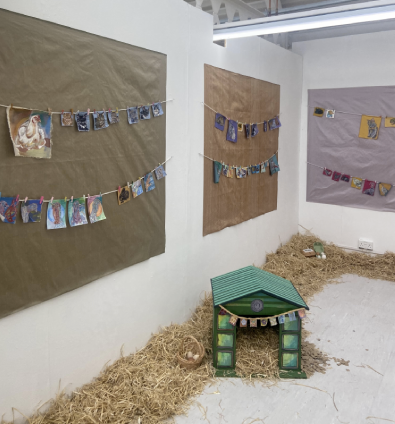DJCAD DEGREE SHOW 2023: FINE ART
Floor 5 – Matthew Building
19 – 28 May 2023
In a dimmed corner of the fine artworks on display on the fifth floor, Maria Touloupa’s Divine Femininity enlightens contemporary female divinity through dreamy saints superimposed upon their reflection on clear acrylic. Touloupa, who is concerned with evanescing traditions and a world which is ‘but a surreal imitation of normality’, accentuates religious iconography with manipulated photography to create an ‘almost illusionary world’ which reflects upon the absurdity of our own world, which is occupied by almost fanatical societal developments such as Artificial Intelligence.
Freya Wilson’s Co-ordinating Chaos, in collaboration with their disabled brother Rory, juxtaposes loud posca-marked acrylic paintings with joyful sensory fabrics to create a safe place for exhibitors dealing with hardship in their twenties. Viewers can conciliate their hidden woes in Wilson’s bravado to proclaim diary-like entries carefreely. Defiant and earnest, Wilson admits that ‘using art as a diary can be exhausting’ but allows for narrative-driven exploration into finding one’s self-worth. The work dissipates the uncomfortable by empowering a cry of despair.
Rosie Nugent’s In My Solitude echos Wilson’s self-liberation through their Paulo Rego-inspired isolating self-portraits. With chiaroscuro heightening the raw trauma of having one’s body integrity violated, the viewer is subjected to return Nugent’s anguished stare. The despairing outlook is a stark reminder that exterior wounds often overlook internal trauma. Nugent’s static portrayal highlights vulnerability, which is in conversation with And Nothing Happened by Naima Ramos-Chapman to illustrate the continuous accounts of victims left helpless by similar suffering.
Sam Torbett-Schofield’s current practice is temporarily placed for the DJCAD Degree Show; the commanding large-scale pinhole camera is used as a mode to collate momentary memories. The photographic images explore the liminal potential of memory, in which Schofield aims to explore memory as continuous navigation rather than a stable recollection. The camera and photos become ‘transitory features of their surroundings’ in which the relationship between remembrance and place is blurred to enable a subliminal quality of tracing memories in the present moment. Gail Necker’s microphotography shares the visceral awe of the supremacy of the universe. PH3 Universal Ice allows Necker to delve into the unaltered beauty of nature through the at-first-unrecognisable yet striking vibrancy of the zoomed-in depictions of ice. One is encouraged to corroborate the subject of the photos by taking a closer look to ensure their initial assumptions of the photographs are true, which cleverly coincides with Necker’s proposition that we must spend deliberate time with our environment.
Ailith Stewart recounts their artistic practice as an ‘exploration and consolidation of ideas’. Their interactive cave installations encourage viewers to travel via the darkened corridor to partake in the historically revered act of ‘aimlessly doodling’. Vandals are welcome. Charcoal is provided. Stewart suggests that those who deface the cave must acknowledge that the interactive action of creation is a more meaningful experience than remaining an onlooker. Value is hence debunked as the pure enjoyment of shared drawing is prioritised. Likewise, June Barton prompts one to become part of the art. Barton’s installation, The Luminous and the Grey, consists of psychedelic projections created by alcohol inks, food colouring, candle dye, water, and mineral oils engulfing the otherwise grey figures in unpredictable colour. With the viewers’ sight distorted by 3-D glasses, Barton manipulates colour into a mask that conceals painful emotions.
Libby Lilburn welcomes the viewer to understand what ‘normal’ is like being Autistic. Lilburn includes the viewer in Life in the MADHOUSE. The sheer volume of Lilburn’s paintings is notable, with ‘100+ paintings’ centred around the ‘45+ pets’ that reside at her childhood home. The surrounding portraits – hung on hand-dyed fabrics – showcase Lilburn’s distinctive upbringing and allow the viewer to bridge the gap between ‘normal and abnormal’.
Adam Louis McIntosh





Leave a Reply